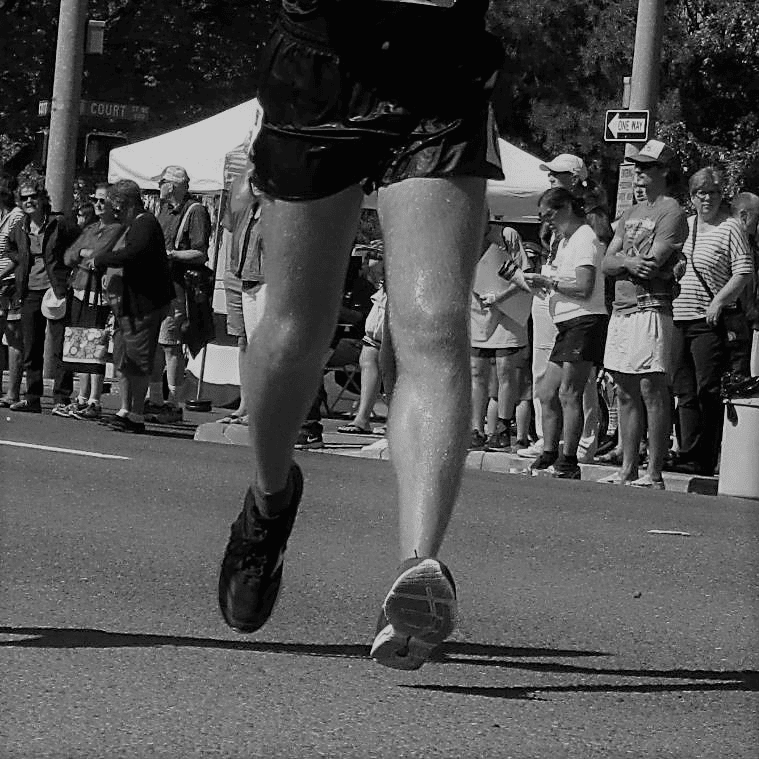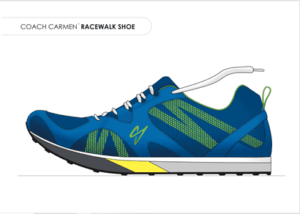If walking is a slower form of running, then running shoes should work just fine, right? Well, not so fast.

Top race walkers can exhibit flight time that is a fraction of a second and still appear to be in contact with the ground to those watching in person, due to their high strike rate.
Many people make the wrong assumption that walking is a slower form of running and therefore surmise that running shoes should work fine. While its true that the activities are similar, there are some significant differences that warrant separate technology. This becomes more obvious as you pick up your walking pace. So let’s look at the competitive walkers.
Footwear is the primary piece of equipment for race walkers, most of whom wear running race flats for training and racing. The reasons seem obvious. Low profile, light weight, flexible shoes allow walkers to “heel-toe” with little resistance. Also, the soft heel foam give athletes a bounce in their step that promotes a technique which looks more like straight legged running than pedestrian walking. So, then it makes sense to wear running shoes, right? Maybe not. Running shoes are designed for an activity that involves vertical propulsion, while race walkers work to avoid vertical motion since their sport requires them to maintain contact with the ground. Based on this fact, are race walkers fighting against the inherent attributes of their shoes with each step? More importantly, can wearing shoes designed for a seemingly contradictory activity produce injuries?
To answer these questions, start by considering the biomechanics of race walking vs. running. When a runner’s heel strikes the ground, their quadriceps engage eccentrically to absorb the ground reaction forces before assisting in the push off phase of each stride. Conversely, when a race walker’s heel strikes the ground, they engage their quads concentrically to exhibit a straight knee. Since concentric contraction is not a stabilizing action, another muscle needs to do that job. Ideally, the glute medius will fire, but what if the walker has weak glutes? Another group of muscles will need to step up. Hamstrings to the rescue!
The problem with relying on the hamstrings to stabilize and motor you forward is that they can be vulnerable to overuse injuries. Consider the fact that this muscle is connected to the knee joint which is stable, and the hip joint, which is mobile. As a walker lands on the heel, the end of the hamstring connected to the knee is contracting to stabilize. At the same time, the walker’s hip is rotating forward and backward, therefore stretching the opposite end of the hamstring. Think of a rubber band that you continually tug on over and over. Eventually, it can tear. The other issue to consider is the vertical motion created by springy heel foam at the same time the hips are rotating. Besides the vertical and rotational forces, we still need to consider foot and ankle posture and the role it plays in supporting the full body weight of the athlete on each step.
Let’s assume that you have a walker with excellent core strength and the glutes are doing their job. However, if this athlete tends to supinate, the soft heel foam can magnify this lateral motion, creating extra stress on the peroneals, which can lead to knee issues.
Race walking has been described as a full-body exercise that requires flexibility and functional integration between the major muscle groups. If that’s true, then a trip to the weight room should solve the collateral damage, right? In a perfect world, that might work, but we’re still left a cycle of dysfunction. Current trends in running shoes offer mono-density midsoles that are soft and springy. Instead of trying to counter the effects of a running shoe, Coach Carmen® decided to create something completely different.
 |
The midsole of a Reshod® Pushover® Walking Shoes has three, angled foam components of varying densities that work together to allow the walker to use the entire surface of the foot to power forward. The toe foam is strategically placed to encourage propulsion to occur AFTER the walker’s hip has passed over the center of gravity. This is crucial for minimizing vertical motion and diverting that energy in a horizontal direction. By the way, this technology works for the casual walker, too! Try it for your next fitness, competitive, occupational, or recreational walk. |
 |
The midsole of a Reshod® Coach Carmen® Race Walking Shoes has four, angled foam components of varying densities that work together to create fast, horizonal motion. The three main sections have a steeper angle than the Reshod® Pushover® Walking Shoes. This lightweight shoe is great for fitness and race walking but also works well on trails and light hikes. |